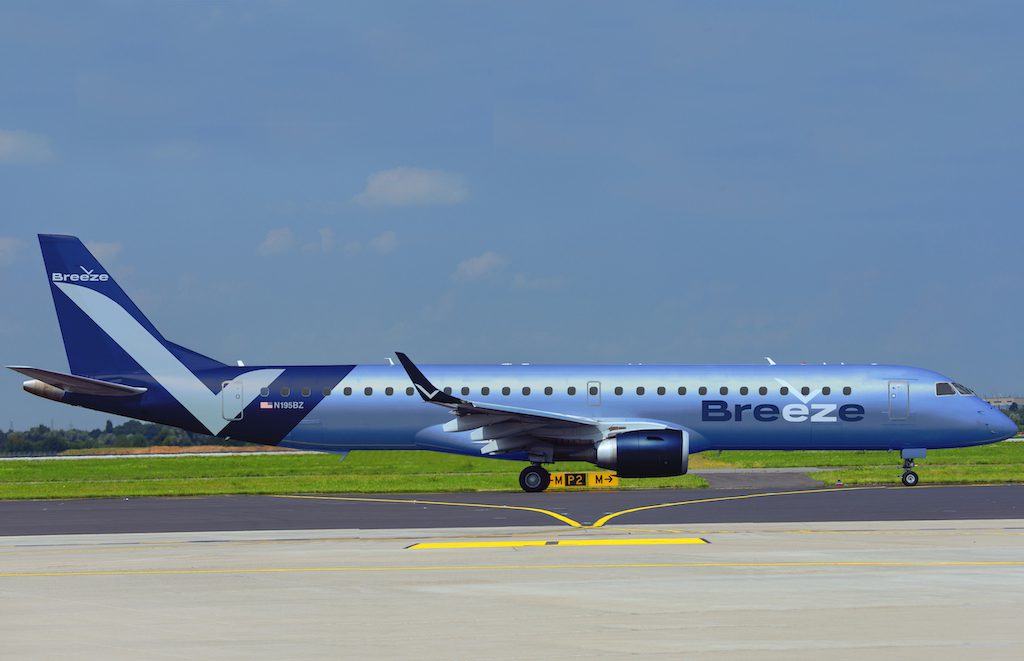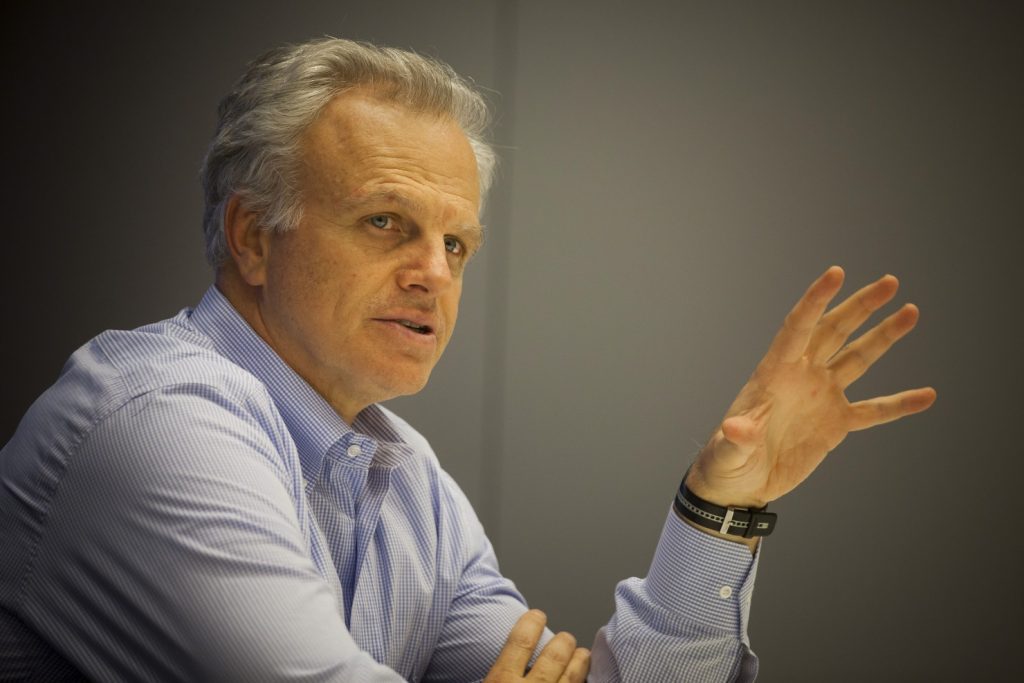Skift Take
David Neeleman's new airline promises to have good service at competitive prices. That's his strategy at every airline, and it's commendable. But Neeleman is also planning to operate what is essentially two business models at once. Can he pull it off?
When David Neeleman’s startup airline, to be called Breeze Airways, begins flying as soon as late this year, customers may focus on its passenger experience, which Neeleman, who founded JetBlue Airways 20 years ago, says will be among the best in the United States. But from a business perspective, Neeleman’s airline is more intriguing for another reason — the chronic airline entrepreneur is pursuing two models at once.
At first, Breeze, which filed Friday for an operating certificate with the U.S. Department of Transportation, will be an Allegiant Air clone, albeit with better service — Neeleman is calling his new carrier “The World’s Nicest Airline” — and fewer fees. Like Allegiant in the late 1990s and early 2000s, Breeze will fly an older, used aircraft no other U.S. carrier wants on routes with little or no competition. Because these airplanes, the Embraer E195, are so cheap to acquire, Breeze may fly them as few as four hours per day and still make money.
Breeze next year will introduce the second part of its strategy. By April 2021, it will add the first of 60 Airbus A220s, a new single-aisle airplane capable of flying coast to coast, to Europe, and to South America. Breeze may load them with premium seats, and could fly them at least 10–12 hours per day, mostly from medium-size markets.
“They are separate missions — one is an apple and one is an orange,” Neeleman said in an interview. “Those planes will never fly on the same route. They won’t be in the same universe, really.”
Few airlines have tried such a gamble. But Neeleman is calculating a mix of lower fares, more nonstop choices, and better service will ensure Breeze siphons customers from established players. Running what is almost two airlines is a challenge, but if anyone can do it, Neeleman is probably the person.
“I’m always skeptical about startups, but Neeleman does have an amazing record and is coming into this with an enormous amount of capital,” said Jay Shabat, senior analyst at Skift Airline Weekly. “This thing is not going to run out of money fast. In that sense, he will have staying power.”
Common Thread
The two strategies have a common thread, because in each case Neeleman is making a contrarian bet against what has become U.S. industry standard. Most U.S. airlines in the past decade have favored larger airplanes over smaller ones, telling investors the approach significantly lowers unit costs and boost profits.
It’s a solid argument based on simple math. When an airline shifts a route from a 150-seat Airbus A320 to a 200-seat Airbus A321, it adds 33 percent more seats it can sell at competitive prices. Its fuel and staff costs go up, too, but not by one-third. On a cost-per-seat basis, the bigger airplane is always better, so long as an airline can fill most of the extra seats.
Some smaller markets with strong economies have thrived from this realignment, with cities like Madison, Wisconsin, seeing more flights from legacy airlines using larger airplanes. Many more have lost service.
Neeleman sees opportunity. Breeze’s 30 E195s will have about 120 seats, and while the per-seat cost will be far greater than it would be on a larger airplane, the total cost for the flight (trip cost, in airline lingo) will be reasonable. With Chief Commercial Officer Lukas Johnson, a former Allegiant executive, choosing routes, Breeze will go where other airlines cannot.
“We only need 50–60 people on board to make it make sense,” Neeleman said.
Breeze will have similar flexibility with A220s, an airplane expected to have between 118 and 145 seats, depending on the market. If Breeze flies it into Europe or South America, it may have a competitive advantage against larger carriers, which generally would use an A321 or an even larger wide-body jet. Again, Neeleman can fly his airplanes from smaller markets than other carriers and make it work.
Unpopular Airplane
Airplane size is not the only trend Neeleman is bucking. In both cases, he is investing in an aircraft shunned by other airlines.
The E190 family is one of the word’s most unloved airplanes, with many carriers, including American Airlines, Azul Airlines, Air Canada, and JetBlue Airways, retiring jets early, blaming poor economics.
Neeleman knows the E195 well, as he ordered it after he founded Azul, a Brazilian low-cost airline, where he is chairman. He acknowledged the early-generation E195s no longer work for Azul but said they’ll be more useful at Breeze, because Breeze acquired them cheaply. Breeze is taking them from Azul under a sublease agreement.
Breeze is getting such a good deal, it won’t even need to fly every plane each day. It can park them when demand plummets and fly them during peak periods, just like Allegiant does with used aircraft.
“The timing is pretty awesome,” Shabat said. “We don’t know exactly what fuel prices will be, but they are pretty low now. That model works even better when you have those old planes and fuel prices are low.”
The A220s are newer and pricier but have a similar story. Today, the A220 is one of the world’s hottest selling airplanes, with Air France-KLM, Air Canada, JetBlue, and Delta Air Lines placing big orders. But Neeleman committed when the program was a disaster, and Bombardier, which developed the airplane before Airbus bailed it out and renamed it, was struggling to find buyers. As a first mover, Neeleman likely got a deal.
Where Will it Fly?
In interviews, Neeleman typically is an oversharer, a rare executive who answers questions directly. But he has repeatedly declined to talk about specific markets.
“I don’t want to give competitors a head start,” he said, adding the airline has a list of 500 potential routes.
He has given hints. In documents shared with investors in 2018, Neeleman suggested Breeze would focus on airports near major cities, like Gary, Indiana, or Providence, Rhode Island. At one point, in its own public filing, the airport in New Haven, Connecticut, suggested it might be a target.
Neeleman gave Skift just one example of a possible route, saying an E195 might work from Idaho Falls, Idaho, to Southern California. On those types of routes, he said, customers could overfly competitor hubs in Salt Lake City or Denver, saving time (and probably money) over one-stop legacy carrier itineraries. (Breeze mostly will be a point-to-point airline, with few customers making connections.)
The A220s probably will fly from midsize cities larger than Idaho Falls and will be configured differently. While the E195s will be all coach, Neeleman said he has been toying with different configurations, including one with up to 36 recliner premium seats and another with lie-flat business class seats.
“We can fly them to Europe,” he said. “We can fly them to South America, even to Hawaii. We can do a lot of different things with that airplane.”
On A220 routes, Breeze may face fierce competition. Established airlines can’t do much to compete with Breeze’s proposed E195 network because they lack the airplanes or infrastructure to fly Idaho Falls to San Diego.
But Delta and JetBlue will both fly A220s, and each has an aggressive management team that might want to stop Neeleman. They could use the same airplanes to try to thwart Breeze’s growth, even if it means losing money short-term.
“There hasn’t been a successful startup airline in the United States in since JetBlue,” Shabat said. “And that was at a time when the legacy carriers were a bloated mess. It was easy. Neeleman came up with this idea of, ‘Why don’t we go into JFK, no one is paying attention?’ These big guys just had costs that were so much higher. But it wouldn’t be that way now. The Deltas and the Americans of the world are tough competitors. They are pretty lean.”
What’s in a Name?
First, the new airline was to be called Moxy, but Marriott, owner of a hotel brand with the same name, complained. Neeleman considered other ideas, but instead went with a simple approach. His company long has been called Breeze Aviation Group.
Neeleman has created or run several airlines over the past three decades, and he said he has never worried about names.
“It’s kind of the name that nobody hated,” he said. “I think of all the names we have ever used, from WestJet to Morris Air. It didn’t really matter what the name was. It is what we make out of it. Breeze is a good name, and I think it gives people good connotations and good feelings. No one is ever against a nice cool breeze.”
Mostly, he said he wants customers to forget about the name and think about the experience.
Breeze should offer a reasonable legroom and friendly service. The airplanes will have Wi-Fi, though it may not be free. Customers will be able to stream live TV on their own devices, but the E195s will not have in-seat TVs.
Breeze could have a more simplified fee structure than the competition, even if it won’t be a fee-free experience.
“I think the ability to have the lowest fare is what people want,” Neeleman said. “Handling baggage costs money. Providing food costs money. If you want to upgrade your experience, you can do that. I think people will appreciate that. It’s all in the way we present it.”
He’s planning to develop what he calls the most advanced mobile app in the airline industry.
“Anything you can imagine you needed to do, you could do on our app,” he said. “You can change or cancel. Or order a filet mignon sandwich if you want. You can pick whatever you want.”
As for the name, Neeleman acknowledged this is the first airline he has founded amid the current social media landscape, where everyone seems to share an opinion. But he said he’s not concerned about possible criticism.
“I honestly don’t really care,” he said. “I really care about if we give good customer service and the plane is on time and people are happy with their flights.”
The Daily Newsletter
Our daily coverage of the global travel industry. Written by editors and analysts from across Skift’s brands.
Have a confidential tip for Skift? Get in touch
Tags: breeze airways, david neeleman, jetblue airways
Photo credit: David Neeleman has great plans for his new U.S. airline, to be called Breeze Airways. Pictured is one of the airline's Embraer E195 jets. Breeze Airways

